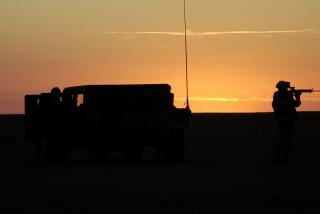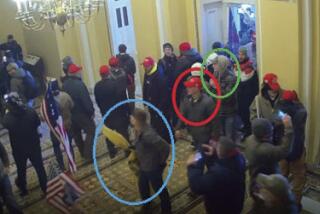For Convoys, Streets Paved With Danger
- Share via
RAMADI, Iraq — As he always does before traveling the roadways of Iraq, Marine Staff Sgt. Johnathan Radel on Tuesday said a short prayer.
“Lord, please keep us safe today from IEDs and VBIEDS,” he said as he sat in his Humvee, using the initials for improvised explosive devices and vehicle-borne improvised explosive devices.
Less than five minutes later, as the eight-vehicle convoy rolled through the streets of Ramadi in the predawn darkness, an IED exploded beneath one of the Humvees, sending an orange fireball into the sky and shredding the vehicle’s back tires. There were no injuries, and the tires were soon replaced.
When the mission was over, with six suspects arrested and a small weapons cache seized, Radel said that reciting the prayer was a habit he picked up recently. “Anything to keep my Marines safe,” he said.
After two years of war and hundreds of U.S. deaths on Iraqi highways and streets caused by roadside bombs and suicide car bombings, the simple task of driving from point A to point B has become a forbidding challenge.
Along the long desert stretches of Al Anbar province or the clogged streets of Ramadi, travel by convoy is a highly choreographed event conducted at high speed. As Sunday’s election approaches and rumors spread of insurgent plans for mass attacks, attention to detail is at its height.
In their Humvee, the driver and the “A-driver,” who is assigned to take over if the driver is killed or wounded, keep phones pressed to their ears. They talk to other Marines in the convoy about road conditions, suspicious civilians, out-of-place vehicles or anything else that could indicate a threat. Medics travel with each convoy.
Relentless IED attacks have taken a physical and emotional toll on the Marines. As many units near the end of their tours of duty, commanders are focused on keeping the troops sharp.
Lt. George Velazquez keeps a grisly photo collection of Humvees and other vehicles destroyed by such blasts. He’s a motor transport officer, frequently assigned to lead convoys through the sniper-infested and bomb-laden streets of Ramadi.
He knows it is a balancing act between protecting Marines and possibly overreacting and hurting or killing civilians.
Like many Marines, Velazquez reenlisted after the Sept. 11 attacks on the U.S. to be part of “the fight.” He had served four years in the enlisted ranks and was ready to become a firefighter with a civilian department. Instead, he re-upped as an officer.
He never figured that Operation Iraqi Freedom would evolve into a guerrilla war in which roadside bombs would reach a kind of deadly perfection.
“It’s nerve-racking,” Velazquez said of the travel. “You’re on edge the whole time. You know [the insurgents] are out there, but on the other hand not everybody is out to hurt you.”
The Marines have distributed pamphlets in Ramadi and elsewhere pleading with residents to keep their distance from convoys and pull to the side of the road until the heavily armed military vehicles pass. There are warning signs on vehicles in Arabic.
Some people don’t get the message, and there have been an untold number of incidents here in which Marines fired on Iraqis who drove too close.
“A certain number of people, inexplicably, drive 85 to 90 mph and won’t obey signs,” said Brig. Gen. Joseph F. Dunford, assistant commander of the 1st Marine Division. “That’s a challenge.”
Nearly every Marine has a story to tell about being in a convoy hit by an IED, a suicide car bomb or a sniper. Bullet holes and cracks in windshields provide proof. Last week, three Army soldiers in Ramadi were killed by a suicide car bombing.
Some Marines prefer to walk than be part of convoys.
“On foot you’re the smallest possible target,” said Pvt. Matt Thompson.
As the Marines have changed since the war began, so have their vehicles. Nearly all Humvees now have gun turrets, as well as armor on the sides and undercarriage; some have bulletproof glass. Compared with the light vehicles -- some with plastic doors -- that crossed the Line of Departure in 2003, these Humvees are more akin to mini-tanks than to the jeeps of previous wars.
On a desert stretch last week, Marines in a line of Humvees scanned the road for anything that might be hiding a bomb: a box, a dead animal, a pothole.
Fences along freeways were removed long ago lest they be used to hide a remote-controlled explosive. Burned spots and twisted metal along the pavement are evidence of previous attacks.
An hours-long trip from Ramadi to a base near the Saudi border passed without a word unrelated to the business at hand from the three Marines inside the Humvee and one with a machine gun standing in the turret.
“There’s no time for talk,” said Lance Cpl. Jeffrey Higgins, a Humvee driver.
The same was true the next day during a shorter trip through Ramadi. On a two-lane bridge over the Euphrates River, an aged blue sedan in front of the convoy slowed to a crawl, a perfect way to put the military vehicles in a vulnerable position.
“Watch the blue car, watch the blue car!” Velazquez barked into his telephone.
In the gun turret, Cpl. Kwasi Djan already had his .50-caliber machine gun trained on the blue car and its occupants. A few tense minutes later, the car and the convoy crept off the bridge. The threat had passed.
“I had him all the way,” Djan said. “Then I noticed that he had kids in the car. I figured he was not dangerous.”
Asked if he’d ever had to fire on Iraqi vehicles that appeared to pose a threat, Djan said: “Oh, yes.”
Then he retreated into silence.
More to Read
Sign up for Essential California
The most important California stories and recommendations in your inbox every morning.
You may occasionally receive promotional content from the Los Angeles Times.













